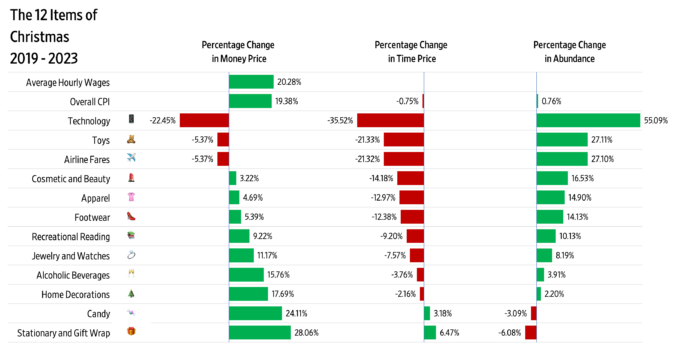This article was originally published at Gale Winds on 12/15/2023.
Did Christmas abundance survive the past four years of government COVID-19 and monetary policies? We went back to November 2019 (just before the pandemic) and looked at the prices of 12 Christmas items, average hourly wages, and the Consumer Price Index (CPI) as reported by the Bureau of Labor Statistics (BLS). We then compared those to today’s reported values.
The first thing we note is that average hourly wages have increased slightly more than the CPI (i.e., 20.28 percent to 19.38 percent). Nine of the 12 items also increased in nominal price. Only technology, toys, and airfares decreased in nominal price.

However, we know that many things have gotten more expense, but the real question is: have they gotten more affordable?
To answer that, we must compare prices to hourly wages. In other words, we must calculate the time price. When we did that, we found that 10 of the 12 items have become less “time” expensive.
Abundance can be measured as a function of the change in time prices over time. How much can you buy with an hour of your time today compared to yesterday? If you can buy more, your life is more abundant.
Between 2019 and 2023, abundance increased by an average of about 13.5 percent, with a 6.08 percent decrease for stationery and gift wrap to a 55.09 percent increase for technology. For the time it took to earn the money to buy one unit in the 2019 basket of Christmas items, you get 1.135 units today.
How is that possible? Abundance increases when we innovate, and innovation is the discovery and sharing of valuable new knowledge. Human beings have a long history of continuing to innovate despite challenges from nature, wars, and bad government policies. Our recent bout of monetary inflation has created noise and distortion and painful redistribution in our economy, but time prices suggest hope and optimism.
What are time prices telling us this year? Eat less candy, recycle your wrapping paper, and enjoy traveling more. Merry Christmas.
Tip of the Hat: Justin Wolfers

